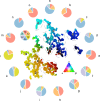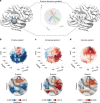Emotionotopy in the human right temporo-parietal cortex
- PMID: 31804504
- PMCID: PMC6895053
- DOI: 10.1038/s41467-019-13599-z
Emotionotopy in the human right temporo-parietal cortex
Abstract
Humans use emotions to decipher complex cascades of internal events. However, which mechanisms link descriptions of affective states to brain activity is unclear, with evidence supporting either local or distributed processing. A biologically favorable alternative is provided by the notion of gradient, which postulates the isomorphism between functional representations of stimulus features and cortical distance. Here, we use fMRI activity evoked by an emotionally charged movie and continuous ratings of the perceived emotion intensity to reveal the topographic organization of affective states. Results show that three orthogonal and spatially overlapping gradients encode the polarity, complexity and intensity of emotional experiences in right temporo-parietal territories. The spatial arrangement of these gradients allows the brain to map a variety of affective states within a single patch of cortex. As this organization resembles how sensory regions represent psychophysical properties (e.g., retinotopy), we propose emotionotopy as a principle of emotion coding.
Conflict of interest statement
The authors declare no competing interests.
Figures






Similar articles
-
Emotions amplify speaker-listener neural alignment.Hum Brain Mapp. 2019 Nov 1;40(16):4777-4788. doi: 10.1002/hbm.24736. Epub 2019 Aug 9. Hum Brain Mapp. 2019. PMID: 31400052 Free PMC article.
-
Two electrophysiological stages of spatial orienting towards fearful faces: early temporo-parietal activation preceding gain control in extrastriate visual cortex.Neuroimage. 2005 May 15;26(1):149-63. doi: 10.1016/j.neuroimage.2005.01.015. Neuroimage. 2005. PMID: 15862215 Clinical Trial.
-
Bottom-Up and Top-Down Factors Differentially Influence Stimulus Representations Across Large-Scale Attentional Networks.J Neurosci. 2018 Mar 7;38(10):2495-2504. doi: 10.1523/JNEUROSCI.2724-17.2018. Epub 2018 Feb 2. J Neurosci. 2018. PMID: 29437930 Free PMC article.
-
Functional imaging of brain responses to pain. A review and meta-analysis (2000).Neurophysiol Clin. 2000 Oct;30(5):263-88. doi: 10.1016/s0987-7053(00)00227-6. Neurophysiol Clin. 2000. PMID: 11126640 Review.
-
Attentional control of the processing of neural and emotional stimuli.Brain Res Cogn Brain Res. 2002 Dec;15(1):31-45. doi: 10.1016/s0926-6410(02)00214-8. Brain Res Cogn Brain Res. 2002. PMID: 12433381 Review.
Cited by
-
Default mode network and dorsal attentional network connectivity changes as neural markers of spinal manipulative therapy in lumbar disc herniation.Sci Rep. 2024 Nov 28;14(1):29541. doi: 10.1038/s41598-024-81126-2. Sci Rep. 2024. PMID: 39604454 Free PMC article. Clinical Trial.
-
Preoperative early-stage lung cancer patients and local brain area changes: a cross-sectional observational descriptive study.Front Psychol. 2024 Aug 14;15:1417668. doi: 10.3389/fpsyg.2024.1417668. eCollection 2024. Front Psychol. 2024. PMID: 39205990 Free PMC article.
-
Beyond shallow feelings of complex affect: Non-motor correlates of subjective emotional experience in Parkinson's disease.PLoS One. 2023 Feb 24;18(2):e0281959. doi: 10.1371/journal.pone.0281959. eCollection 2023. PLoS One. 2023. PMID: 36827296 Free PMC article.
-
Cerebral Volumetric Correlates of Apathy in Alzheimer's Disease and Cognitively Normal Older Adults: Meta-Analysis, Label-Based Review, and Study of an Independent Cohort.J Alzheimers Dis. 2022;85(3):1251-1265. doi: 10.3233/JAD-215316. J Alzheimers Dis. 2022. PMID: 34924392 Free PMC article.
-
Inter- and intra-subject similarity in network functional connectivity across a full narrative movie.Hum Brain Mapp. 2024 Aug 1;45(11):e26802. doi: 10.1002/hbm.26802. Hum Brain Mapp. 2024. PMID: 39086203 Free PMC article.
References
Publication types
MeSH terms
LinkOut - more resources
Full Text Sources
Research Materials

